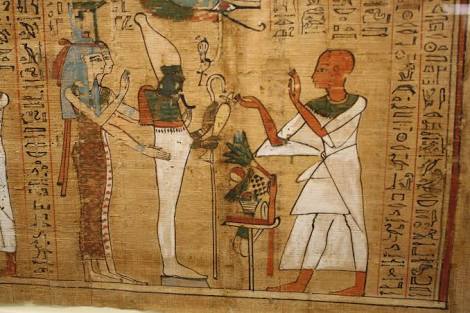.jpg)
The Egyptian Book of the Dead is a collection of spells which enable the soul of the deceased to navigate the afterlife. The famous title was given the work by western scholars; the actual title would translate as The Book of Coming Forth by Day or Spells for Going Forth by Day and a more apt translation to English would be The Egyptian Book of Life. Although the work is often referred to as "the Ancient Egyptian Bible" it is no such thing although the two works share the similarity of being ancient compilations of texts written at different times eventually gathered together in book form. The Book of the Dead was never codified and no two copies of the work are exactly the same. They were created specifically for each individual who could afford to purchase one as a kind of manual to help them after death. Egyptologist Geralidine Pinch explains:
The Egyptian Book of the Dead is a term coined in the nineteenth century CE for a body of texts known to the Ancient Egyptians as the Spells for Going Forth by Day. After the Book of the Dead was first translated by Egyptologists, it gained a place in the popular imagination as the Bible of the Ancient Egyptians. The comparison is very inappropriate. The Book of the Dead was not the central holy book of Egyptian religion. It was just one of a series of manuals composed to assist the spirits of the elite dead to achieve and maintain a full afterlife (26).
The afterlife was considered to be a continuation of life on earth and, after one had passed through various difficulties and judgment in the Hall of Truth, a paradise which was a perfect reflection of one's life on earth. After the soul had been justified in the Hall of Truth it passed on to cross over Lily Lake to rest in the Field of Reeds where one would find all that one had lost in life and could enjoy it eternally. In order to reach that paradise, however, one needed to know where to go, how to address certain gods, what to say at certain times, and how to comport one's self in the land of the dead; which is why one would find an afterlife manual extremely useful.
HAVING A BOOK OF THE DEAD IN ONE'S TOMB WOULD BE THE EQUIVALENT OF A STUDENT IN THE MODERN DAY GETTING THEIR HANDS ON ALL THE TEST ANSWERS THEY WOULD EVER NEED.
THE HISTORY
The Book of the Dead originated from concepts depicted in tomb paintings and inscriptions from as early as the Third Dynasty of Egypt (c. 2670 - 2613 BCE). By the 12th Dynasty (1991 - 1802 BCE) these spells, with accompanying illustrations, were written on papyrus and placed in tombs and graves with the dead. Their purpose, as historian Margaret Bunson explains, "was to instruct the deceased on how to overcome the dangers of the afterlife by enabling them to assume the form of serveral mythical creatures and to give them the passwords necessary for admittance to certain stages of the underworld" (47). They also served, however, to provide the soul with fore-knowledge of what would be expected at every stage. Having a Book of the Dead in one's tomb would be the equivalent of a student in the modern day getting their hands on all the test answers they would ever need in every grade of school.
At some point prior to 1600 BCE the different spells had been divided in chapters and, by the time of the New Kingdom (1570 - 1069 BCE), the book was extremely popular. Scribes who were experts in spells would be consulted to fashion custom-made books for an individual or a family. Bunson notes, "These spells and passwords were not part of a ritual but were fashioned for the deceased, to be recited in the afterlife" (47). If someone were sick, and feared they might die, they would go to a scribe and have them write up a book of spells for the afterlife. The scribe would need to know what kind of life the person had lived in order to surmise the type of journey they could expect after death; then the appropriate spells would be written specifically for that individual

Book of the Dead of Tayesnakht
Prior to the New Kingdom, The Book of the Dead was only available to the royalty and the elite. The popularity of the Osiris Myth in the period of the New Kingdom made people believe the spells were indispensible because Osiris featured so prominently in the soul's judgment in the afterlife. As more and more people desired their own Book of the Dead, scribes obliged them and the book became just another commodity produced for sale. In the same way that publishers in the present day offer Print on Demand books or self-published works, the scribes offered different "packages" to clients to choose from. They could have as few or as many spells in their books as they could afford. Bunson writes, "The individual could decide the number of chapters to be included, the types of illustrations, and the quality of the papyrus used. The individual was limited only by his or her financial resources
Follow and upvote @pufoyoung
Hi! I am a robot. I just upvoted you! I found similar content that readers might be interested in:
http://www.ancient.eu/Egyptian_Book_of_the_Dead/
Downvoting a post can decrease pending rewards and make it less visible. Common reasons:
Submit